Entry-level Mini-ITX board offers HD video output
Sep 27, 2011 — by LinuxDevices Staff — from the LinuxDevices Archive — 8 viewsVia Technologies added to its range of Mini-ITX boards with an “entry-level” product featuring a 1.0GHz C7 processor. The Epia-M720 supports up to 4GB of DDR3 memory, has VGA and HDMI video outputs, has a wealth of onboard and coastline I/O, and is offered with five different expansion modules, the company says.
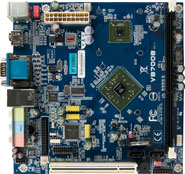 A longtime champion of the 6.7 by 6.7-inch Mini-ITX motherboard form factor it devised back in 2004, Via has recently emphasized relatively powerful variants such as the VB8004 and Epia-M900 (both packing the dual-core Nano X2 E-Series processor). The new Epia-M720 (pictured), however, is described as an entry-level product that's an upgrade to the Epia-LN and Epia-M700.
A longtime champion of the 6.7 by 6.7-inch Mini-ITX motherboard form factor it devised back in 2004, Via has recently emphasized relatively powerful variants such as the VB8004 and Epia-M900 (both packing the dual-core Nano X2 E-Series processor). The new Epia-M720 (pictured), however, is described as an entry-level product that's an upgrade to the Epia-LN and Epia-M700.
Like these previous boards, it employs a 1.0GHz Via C7 processor. However, the Epia-LN and Epia M-700 respectively used Via's VX700 and VX800 northbridge/southbridge chips, whereas the Epia-M720 steps up to the VX900, announced in March 2010.
Touted for its ability to provide 1080p video playback "without incurring a heavy CPU load," the VX900 offers hardware acceleration for H.264 video. The 31 x 31mm device also accelerates MPEG-4/AVC, MPEG-2, VC-1, WMV-HD, AVS, Blu-ray, and "advanced browser streamed video technologies," all at "true HD" resolutions, the company adds.
According to Via, the VX900's ChromotionHD 2.0 video engine is also said to provide motion compensation, transform, de-blocking, and AVS support. Integrated display capabilities include a dedicated CRT interface, an LVDS transmitter, a multiplexed display interface for DisplayPort and HDMI, and a 12-bit digital video output port (DVP) for an external HMDI/LVDS/DVI transmitter.
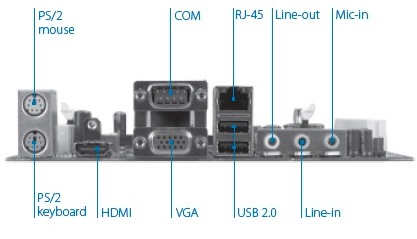
Epia-M720 ports
Via leverages these capabilities on the Epia-M720 by providing both VGA and HDMI ports on the board's coastline (above). Other I/O on the edge of the board includes two PS/2 ports, a serial port, two USB 2.0 ports, a gigabit Ethernet port, and three 3.5mm audio jacks for line output, line in, and mic in, according to the company.
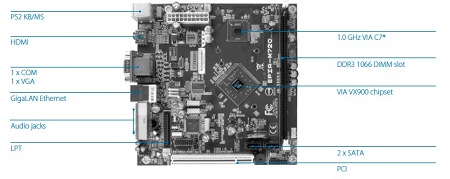
Epia-M720 detail
(Click to enlarge)
According to Via, the Epia-M720 also provides a bevy of headers for additional I/O. These are said to serve up six additional USB 2.0 ports, a second serial port, another PS/2 port, a parallel port, "front-panel" audio, S/PDIF output, and two SATA connectors, among other things.
Via says the Epia-M720 can accept up to 4GB of DDR3 memory via its single DIMM socket. A single PCI expansion slot is standard, but two slots can be provided via an optional EXT-PCI riser card, the company adds.
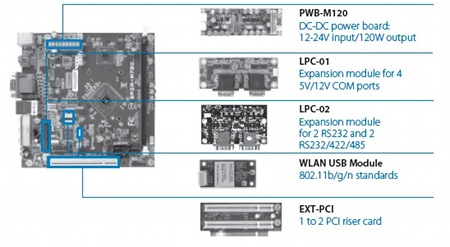
Optional modules for the Epia-M720
(Click to enlarge)
As pictured above, four other expansion modules are offered by Via for the Epia-M720. They include: the PWB-M120, a DC-to-DC power board that allows input ranging from 12 to 24 Volts; the LPC-01, which adds four powered (5/12V) serial ports; the LPC-02, which adds two RS232 ports and two RS232/422/485 ports; and the WLAN USB Module, providing 802.11b/g/n wireless networking.
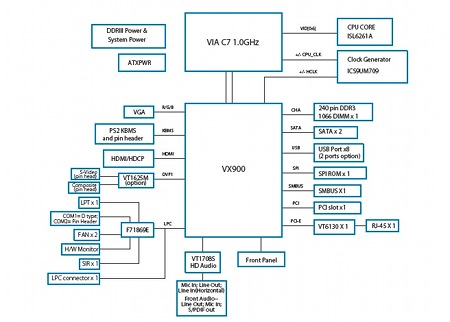
Epia-M720 block diagram
(Click to enlarge)
Features and specifications listed by Via for the Epia-M720 include:
- Processor — Via C7 clocked at 1.0GHz
- Chipset — Via VX900
- Memory — up to 4GB of DDR3 RAM
- Expansion — 1 x PCI (or 2 with optional riser card)
- Networking — 1 x gigabit Ethernet (rear panel)
- Other I/O:
- Rear panel:
- 2 x PS/2
- 1 x VGA
- 1 x HDMI
- 1 x RS232
- 2 x USB 2.0
- audio — mic in, line in, line out
- Onboard headers:
- 6 x USB 2.0
- 1 x front-panel audio
- 1 x S/PDIF out
- 1 x PS/2
- 1 x COM2
- 1 x parallel
- 1 x LPC
- 1 x SMBus
- 1 x SPI
- 1 x SIR
- 2 x SATA
- Rear panel:
- Operating temperature — 32 to 140 deg. F (0 to 60 deg. C)
- Dimensions — 6.7 x 6.7 inches (17 x 17cm); Mini-ITX
- Operating system — Linux, Windows 7, Windows Embedded Standard 7, Windows CE, Windows XP/XPe
Further information
Via did not cite pricing or availability for the Epia-M720. More information may be found on the company's Epia-M720 product page.
Jonathan Angel can be reached at [email protected] and followed at www.twitter.com/gadgetsense.
This article was originally published on LinuxDevices.com and has been donated to the open source community by QuinStreet Inc. Please visit LinuxToday.com for up-to-date news and articles about Linux and open source.